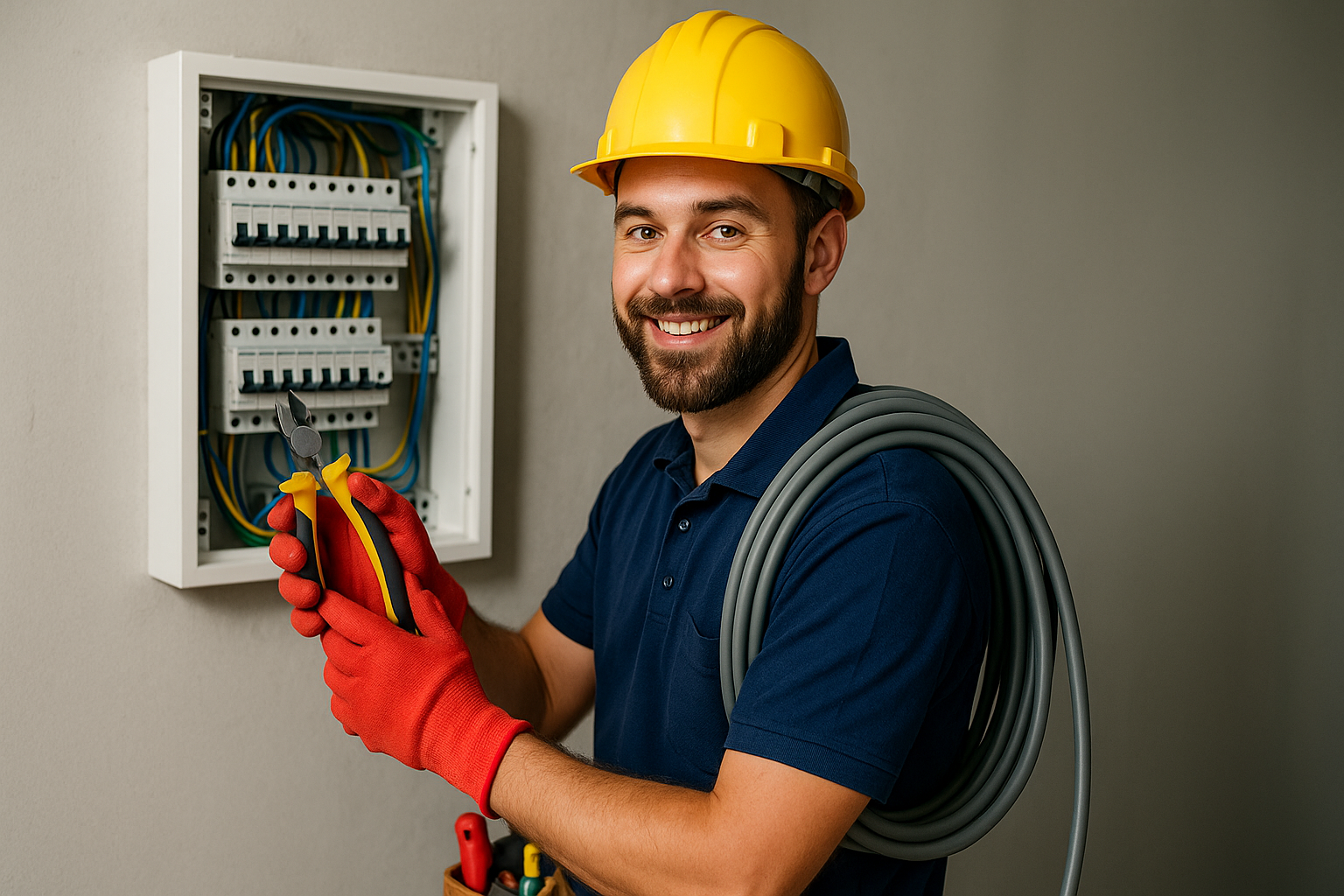Pets are naturally curious creatures. Whether it’s a puppy chasing cables, a cat playing with a dangling charger, or a rabbit exploring behind furniture, our furry companions love to investigate their surroundings. Unfortunately, this curiosity can put them in danger when it comes to electrical devices and wiring.
Every year, many pets suffer from electrical burns, shocks, or injuries caused by chewing wires, knocking over appliances, or getting tangled in cords. As responsible pet owners, it’s our duty to make our homes safe not only for people but also for our animal friends.
This guide explains how to keep pets safe around electrical devices from prevention and protection to training and emergency steps.
Understand Why Pets Are Attracted to Electrical Devices
The first step in preventing accidents is understanding why pets go near electrical items in the first place.
-
Chewing instinct: Dogs, rabbits, and some cats naturally chew objects, especially when they’re teething or bored. Cables resemble toys or sticks.
-
Movement and texture: Dangling cords and flashing lights can trigger play instincts in cats and young animals.
-
Warmth: Some pets, like cats, are drawn to the warmth of electronics such as laptops, modems, or gaming consoles.
-
Exploration: Pets explore the world with their noses and mouths, not realizing that cords and sockets can be dangerous.
Knowing these triggers helps you take preventive steps to reduce temptation.
Hide or Cover Electrical Cords
Loose or exposed cords are one of the biggest hazards for pets. They can chew on them, trip over them, or get tangled.
Tips to make cords safer:
-
Use cord protectors: Plastic or flexible tubing designed for cable management can make wires less appealing to chew.
-
Hide cords behind furniture: Push desks, shelves, or entertainment units close to the wall to block access.
-
Run cables through cord organizers or cable boxes: These not only keep cords tidy but also keep them out of sight.
-
Avoid dangling cords: Secure them with clips or tape so they don’t attract playful pets.
If your pet has a favorite spot where cords are accessible, rearrange furniture or use barriers to block it off.
Keep Devices Out of Reach
Many small electrical devices such as phone chargers, hair dryers, fans, or lamps are within easy reach of pets. Cats might jump onto counters, while dogs and rabbits can access low shelves.
What you can do:
-
Place small appliances on high, stable surfaces or inside closed cabinets.
-
Unplug devices when not in use. A charger left plugged in can still conduct electricity, even if it’s not connected to a phone.
-
Keep pets out of rooms where you’re using high-risk devices, such as irons or space heaters.
This reduces the risk of burns, shocks, and even fires caused by knocked-over appliances.
Unplug Devices When You’re Away
When you’re not home to supervise your pets, unplug unnecessary electronics. Not only does this save energy, but it also eliminates potential hazards if your pet decides to play or chew while you’re gone.
Some appliances retain electricity even when turned off, so unplugging them completely is the safest option. Pay special attention to:
-
Chargers
-
Kitchen appliances
-
Lamps and fans
-
Electric blankets
A few seconds of prevention can make a big difference in your pet’s safety.
Use Pet-Safe Deterrents
If your pet can’t resist the urge to chew, you can use safe deterrent sprays that discourage them from biting cords. Many pet stores sell bitter-tasting sprays made specifically for this purpose.
How to use them effectively:
-
Spray directly onto cords and repeat every few days.
-
Test a small section first to ensure it doesn’t damage the cord’s surface.
-
Combine deterrents with positive reinforcement – reward your pet for ignoring cords or staying away from them.
Never use homemade solutions like vinegar or chili; they may harm your pet’s skin, eyes, or sense of smell.
Manage Power Strips and Outlets
Power strips and outlets are often hidden on the floor – exactly where pets love to explore. A curious paw or nose can easily come into contact with an exposed socket.
Ways to make outlets safer:
-
Use outlet covers to block unused sockets.
-
Keep power strips behind furniture or inside protective boxes.
-
Choose surge protectors with built-in safety covers or child-proof designs.
-
Avoid overloading outlets, which can overheat and cause fires.
Also, avoid leaving extension cords lying across areas where pets walk or play. They can trip or pull on them accidentally.
Be Cautious With Heated and Moving Devices
Heated blankets, space heaters, and fans are attractive to pets because of the warmth and movement they produce. However, they can be dangerous if tipped over or damaged.
Safety tips:
-
Supervise pets around portable heaters or electric blankets.
-
Keep cords and heating elements out of reach.
-
Turn off and unplug devices when leaving the room.
-
Use heaters with automatic shut-off features to prevent overheating.
Remember: even if your pet enjoys curling up near a heater, it only takes a moment for an accident to happen.
Keep Water and Electronics Separate
Pets often knock over water bowls or play in wet areas, which increases the risk of electric shock. Water is an excellent conductor of electricity, so mixing the two is never safe.
Precautions to take:
-
Keep water bowls far from electrical outlets or appliances.
-
Don’t place devices like fish tank filters or heaters where pets can chew the cords.
-
Immediately wipe up any spills near electronics.
-
In outdoor areas, ensure all electrical connections are weatherproof and raised off the ground.
If your pet frequently drinks from toilets or puddles, keep bathroom doors closed during storms or when using electrical grooming tools.
Train Your Pet to Avoid Electrical Areas
Training plays a big role in long-term safety. Just as pets learn not to jump on counters or chew shoes, they can be taught to stay away from cords and devices.
Tips for effective training:
-
Use clear commands like “No” or “Leave it” when your pet approaches cords.
-
Redirect their attention with toys or treats.
-
Create designated play zones away from electrical areas.
-
Reward them for positive behavior consistently.
Cats can also be trained using double-sided tape or aluminum foil in restricted areas – most dislike the texture and sound.
Know What to Do in an Emergency
Even with all precautions, accidents can still happen. Knowing how to respond quickly can save your pet’s life.
If your pet is electrocuted:
-
Don’t touch your pet immediately. The electrical current may still be active — turn off the power source first or unplug the device safely.
-
Check for breathing and consciousness. If your pet is unconscious, start CPR if you’re trained to do so.
-
Seek veterinary help immediately. Burns or shocks may cause internal injuries that aren’t visible.
-
Avoid water. Never pour water on your pet or the device – it can worsen the shock.
After an incident, always have your vet check your pet even if they seem fine. Electrical injuries can cause heart or nerve problems that develop later.
A Safe Home for You and Your Pets
Keeping pets safe around electrical devices doesn’t have to be complicated. With a few preventive steps – hiding cords, unplugging devices, using deterrents, and training your pets – you can create a safe environment for everyone in your home.
Remember, pets don’t understand the dangers of electricity. They rely on you to protect them. A little effort and awareness today can prevent painful injuries or tragic accidents tomorrow.
By securing your home and staying alert, you’re not just keeping your electronics safe – you’re protecting the health, comfort, and happiness of your beloved furry family members.

